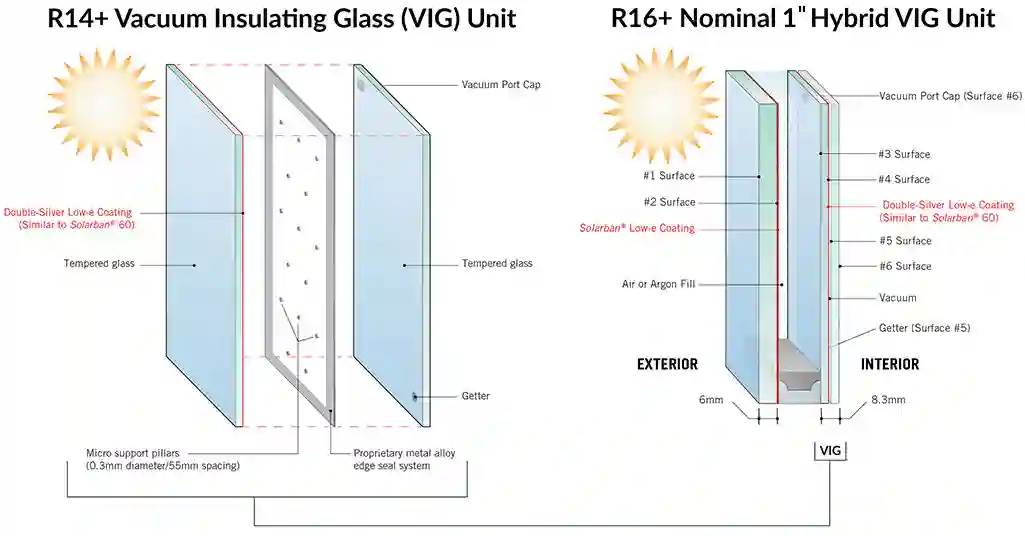Whether you’re installing a new conservatory or renovating an existing one, oversized vacuum glazing can offer a number of benefits. It can be a cost-effective way to reduce heat loss and improve the energy efficiency of your building, and is also a great way to keep the view clear in winter.
Pilkington Spacia
Using vacuum technology, Pilkington Spacia oversized vacuum glazing is the world’s first commercially available product of its kind. The new product has been designed to offer the thermal performance of a double, triple or even a quadruple glazing product while fitting seamlessly into your traditional property. The product can also be retrofitted into existing frames, making it suitable for period and heritage properties.
The key features of the product are the low-emissivity coating, the low U value and the high light transmission. The unit also has a micro-spacer grid which is composed of small glass pillars that are set 20mm apart. The unit is also equipped with an intelligent camera checking system, which is designed to check that the unit is working properly. The edges are also sealed with a low melting point glass frit. The unit is light weight and can be fitted into virtually any conventional glazing system. It is available in sizes from 12″x12″ to 58″x96″ and can be used for single, triple and quadruple glazed “super-windows.” It can also be used for sliding box sashes.
Fully Tempered Vacuum Glazing
FTVG is an innovative new type of vacuum glazing. It is made up of two fully tempered glass sheets with a low-emissivity coating. Its heat transfer mechanisms include conduction and thermal radiation. It is installed in the same way as traditional insulation glass. FTVG is developed by Panasonic to provide noiseless visibility and high heat insulating performance. It is also very manageable and light weight. It is widely used in glass windows and glass facades. It is easy to install and fit into existing window frames. It has excellent impact resistance and wind pressure resistance. It is more energy efficient and has a better insulation value.
FTVG is composed of two 4- or 5-mm thick fully tempered glass sheets. A supporting ball array, consisting of 60 mm diameter balls, is placed in an equilateral triangle mode. This reduces the number of support spacers. The radius of the ball should be 0.25 mm. The 3D finite element model of the center unit cell of FTVG has been established to determine the thermal transmission. The predicted U-values are 0.26 W/m2 K. They are in good agreement with the mathematical model.
Ultra-Glaze 1000 Specialist Vacuum Lifter
Designed for safe lifting of oversized glass, the Ultra-Glaze 1000 specialist vacuum lifter is the ultimate machine for lifting heavy glass. It offers 1300*2900 vacuum insulating glass rotation, adjustable suction pads, a powered tilt, and an electronic blow off. This is a great tool to maximize productivity and minimize workplace injuries.
While the Ultra-Glaze 1000 is not the first vacuum lifter on the market, it is the first to offer a remote control vacuum system. This allows the operator more flexibility and control than the standard manual version. This is the best vacuum lifter for any job.
The most important feature of the Ultra-Glaze 1000 is the capability to lift a wide variety of textured and large-format glass. With an impressive maximum capacity of 3000kg, you can safely lift anything you can imagine. The machine also consists of a powerful telescopic boom, a proportional hydraulic system, and a wireless counterweight system. Among the many features that make this device unique are its rechargeable high-capacity 24 volt system, its vacuum safety chamber, and its self-holding system.
Costs
Compared to conventional double glazing, the cost of vacuum insulated glazing is lower. This is because it uses thinner glass and a metal material to create a sealed system. The result is a more effective window. It also has better thermal insulation and acoustic performance. The U-factor of vacuum glazing is similar to that of double glazing. It is the rate of heat transmission through the material. If the U-factor is 0.2 W m-2 K-1, it means that the thermal performance of the vacuum insulating glass is a little better than that of double glazing.
The vacuum insulated glazing also has lower conduction and convection heat losses. The internal vacuum of the vacuum glazing is very stable over long periods of time at moderate temperatures. This makes the vacuum insulated glass more effective than gas filled windows. In addition, the internal vacuum of vacuum glazing eliminates the effect of air and gaseous convection. This is a big advantage for vacuum insulated glazing, especially in historic renovations.
Final Word
Unlike traditional double glazing, vacuum glazing uses thinner glass and high-strength spacers to achieve insulation performance up to 0.4 W m2 K-1. Compared to conventional insulated glass, the use of vacuum glazing has the potential to reduce thermal transmission through translucent facades and impact energy use.



